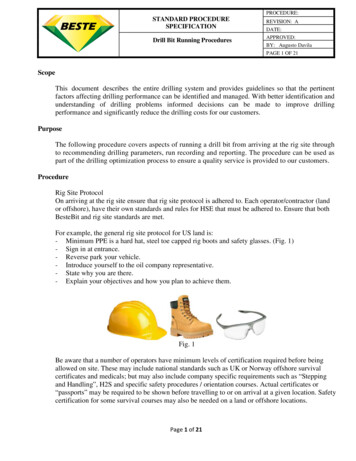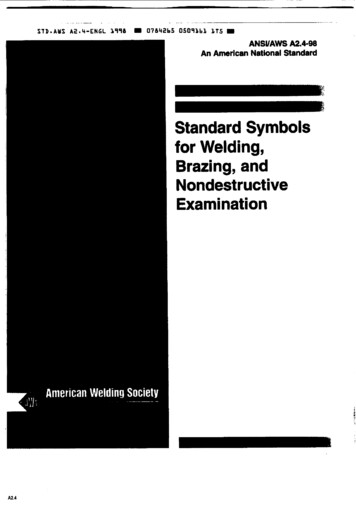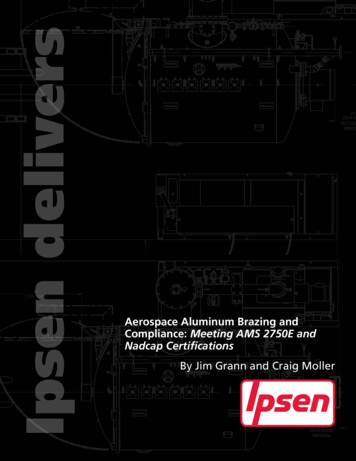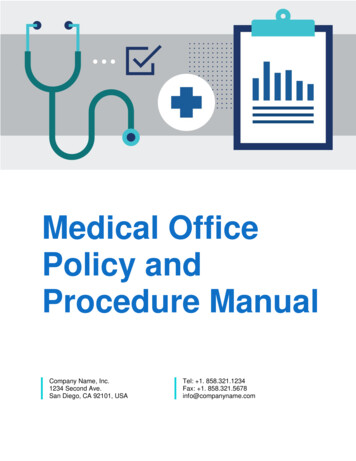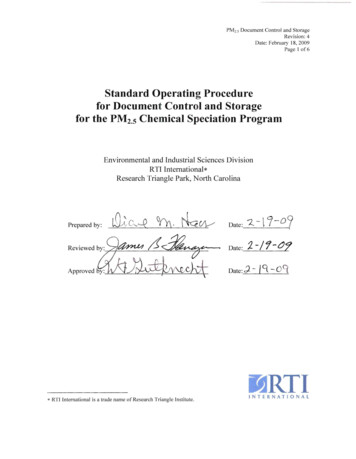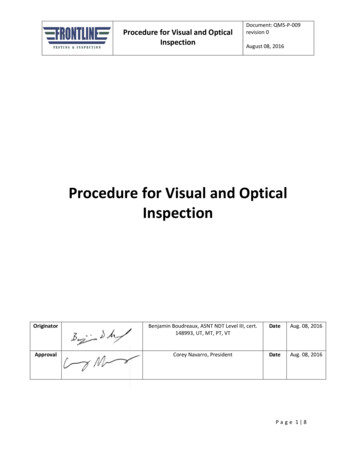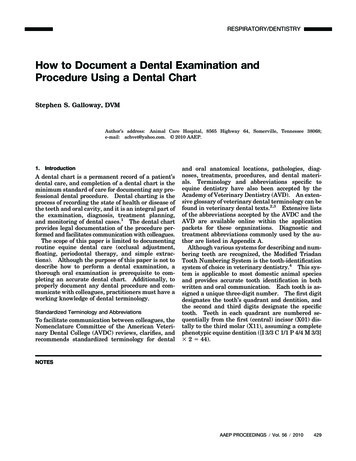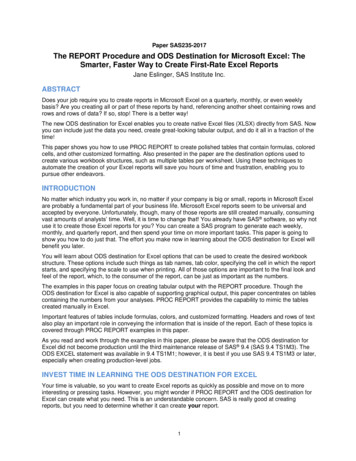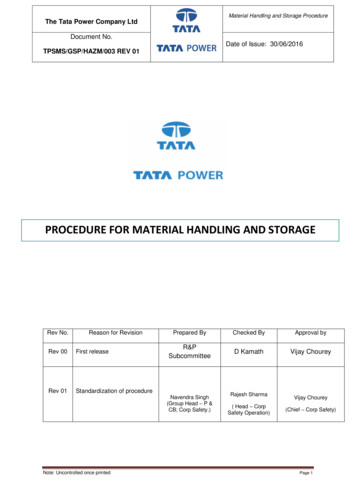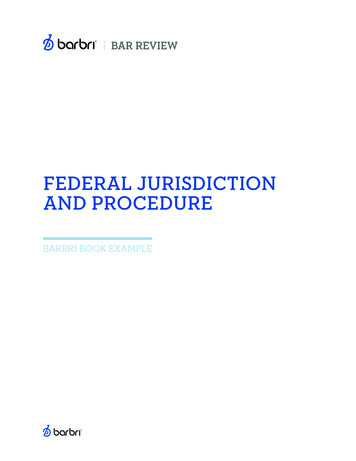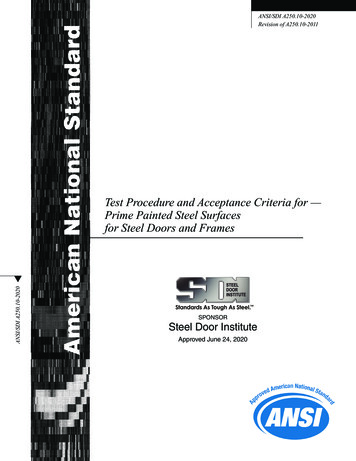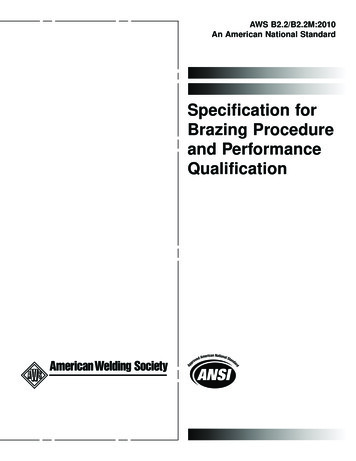
Transcription
AWS B2.2/B2.2M:2010An American National StandardSpecification forBrazing Procedureand PerformanceQualification
AWS B2.2/B2.2M:2010An American National StandardApproved by theAmerican National Standards InstituteJuly 7, 2009Specification forBrazing Procedure andPerformance Qualification3rd EditionSupersedes ANSI/AWS B2.2-91Prepared by theAmerican Welding Society (AWS) B2 Committee on Procedure and Performance QualificationUnder the Direction of theAWS Technical Activities CommitteeApproved by theAWS Board of DirectorsAbstractThis specification provides the requirements for qualification of brazing procedure specifications, brazers, and brazingoperators for manual, mechanized, and automatic brazing. The brazing processes included are torch brazing, furnacebrazing, diffusion brazing, resistance brazing, dip brazing, infrared brazing, and induction brazing. Base metals, brazingfiller metals, brazing fluxes, brazing atmospheres, and brazing joint clearances are also included.550 N.W. LeJeune Road, Miami, FL 33126
AWS B2.2/B2.2M:2010International Standard Book Number: 978-0-87171-762-7American Welding Society550 N.W. LeJeune Road, Miami, FL 33126 2009 by American Welding SocietyAll rights reservedPrinted in the United States of AmericaAmended: April 22, 2010Photocopy Rights. No portion of this standard may be reproduced, stored in a retrieval system, or transmitted in anyform, including mechanical, photocopying, recording, or otherwise, without the prior written permission of the copyrightowner.Authorization to photocopy items for internal, personal, or educational classroom use only or the internal, personal, oreducational classroom use only of specific clients is granted by the American Welding Society provided that the appropriatefee is paid to the Copyright Clearance Center, 222 Rosewood Drive, Danvers, MA 01923, tel: (978) 750-8400; Internet: www.copyright.com .ii
AWS B2.2/B2.2M:2010Statement on the Use of American Welding Society StandardsAll standards (codes, specifications, recommended practices, methods, classifications, and guides) of the AmericanWelding Society (AWS) are voluntary consensus standards that have been developed in accordance with the rules of theAmerican National Standards Institute (ANSI). When AWS American National Standards are either incorporated in, ormade part of, documents that are included in federal or state laws and regulations, or the regulations of other governmental bodies, their provisions carry the full legal authority of the statute. In such cases, any changes in those AWSstandards must be approved by the governmental body having statutory jurisdiction before they can become a part ofthose laws and regulations. In all cases, these standards carry the full legal authority of the contract or other documentthat invokes the AWS standards. Where this contractual relationship exists, changes in or deviations from requirementsof an AWS standard must be by agreement between the contracting parties.AWS American National Standards are developed through a consensus standards development process that bringstogether volunteers representing varied viewpoints and interests to achieve consensus. While the AWS administers theprocess and establishes rules to promote fairness in the development of consensus, it does not independently test, evaluate, or verify the accuracy of any information or the soundness of any judgments contained in its standards.AWS disclaims liability for any injury to persons or to property, or other damages of any nature whatsoever, whetherspecial, indirect, consequential, or compensatory, directly or indirectly resulting from the publication, use of, or relianceon this standard. AWS also makes no guarantee or warranty as to the accuracy or completeness of any informationpublished herein.In issuing and making this standard available, AWS is neither undertaking to render professional or other services for oron behalf of any person or entity, nor is AWS undertaking to perform any duty owed by any person or entity to someoneelse. Anyone using these documents should rely on his or her own independent judgment or, as appropriate, seek theadvice of a competent professional in determining the exercise of reasonable care in any given circumstances. It isassumed that the use of this standard and its provisions are entrusted to appropriately qualified and competent personnel.This standard may be superseded by the issuance of new editions. Users should ensure that they have the latest edition.Publication of this standard does not authorize infringement of any patent or trade name. Users of this standard acceptany and all liabilities for infringement of any patent or trade name items. AWS disclaims liability for the infringement ofany patent or product trade name resulting from the use of this standard.Finally, the AWS does not monitor, police, or enforce compliance with this standard, nor does it have the power to do so.On occasion, text, tables, or figures are printed incorrectly, constituting errata. Such errata, when discovered, are postedon the AWS web page (www.aws.org).Official interpretations of any of the technical requirements of this standard may only be obtained by sending a request,in writing, to the appropriate technical committee. Such requests should be addressed to the American Welding Society,Attention: Managing Director, Technical Services Division, 550 N.W. LeJeune Road, Miami, FL 33126 (see Annex G).With regard to technical inquiries made concerning AWS standards, oral opinions on AWS standards may be rendered.These opinions are offered solely as a convenience to users of this standard, and they do not constitute professionaladvice. Such opinions represent only the personal opinions of the particular individuals giving them. These individualsdo not speak on behalf of AWS, nor do these oral opinions constitute official or unofficial opinions or interpretations ofAWS. In addition, oral opinions are informal and should not be used as a substitute for an official interpretation.This standard is subject to revision at any time by the AWS B2 Committee on Procedure and Performance Qualification.It must be reviewed every five years, and if not revised, it must be either reaffirmed or withdrawn. Comments (recommendations, additions, or deletions) and any pertinent data that may be of use in improving this standard are requiredand should be addressed to AWS Headquarters. Such comments will receive careful consideration by the AWS B2Committee on Procedure and Performance Qualification and the author of the comments will be informed of theCommittee’s response to the comments. Guests are invited to attend all meetings of the AWS B2 Committee on Procedureand Performance Qualification to express their comments verbally. Procedures for appeal of an adverse decisionconcerning all such comments are provided in the Rules of Operation of the Technical Activities Committee. A copy ofthese Rules can be obtained from the American Welding Society, 550 N.W. LeJeune Road, Miami, FL 33126.iii
AWS B2.2/B2.2M:2010This page is intentionally blank.iv
AWS B2.2/B2.2M:2010PersonnelAWS B2 Committee on Procedure and Performance QualificationJ. J. Fluckiger, ChairJ. L. Cooley, 1st Vice ChairE. W. Beckman, 2nd Vice ChairS. Morales, SecretaryL. P. ConnorW. D. DotyE. H. GrayB. J. HableM. HerrleR. A. LaFaveK.Y. LeeK. M. McTagueA. S. OlivaresJ. F. PikeW. M. RuofJ. J. SekelyM. R. StoneG. M. Wisbrock, Jr.R. K. WiswesserIdaho National LaboratoryJ. C. & Associates, IncorporatedInternational Training InstituteAmerican Welding SocietyConsultantDoty and Associates, IncorporatedU.S. Nuclear Regulatory CommissionFord Motor CompanyArise, IncorporatedElliott Company, IncorporatedThe Lincoln Electric CompanyFactory MutualHSB Global StandardsNASA Langley Research CenterBechtel Plant Machinery, IncorporatedWelding Services, IncorporatedCanadian Welding BureauLockheed Martin Missiles & Fire Control (Retired)Welder Training and Testing InstituteAdvisors to the AWS B2 Committee on Procedure and Performance QualificationW. L. BallisJ. D. DuncanN. K. KanayaB. B. MacDonaldA. W. SindelC. E. Spaeder, Jr.W. J. SperkoR. F. WaiteConsultantConsultantBEAR Testing LaboratoryConsultantAlstom Power, IncorporatedAristech Chemical CorporationSperko Engineering ServicesConsultantAWS B2A Subcommittee on Brazing QualificationJ. L. Cooley, ChairS. Morales, SecretaryJ. J. FluckigerL. GuimaraesR. A. LaFave*R. L. PeasleeW. J. SperkoK. P. ThornberryG. M. Wisbrock, Jr.R. K. WiswesserJ. C. & Associates, IncorporatedAmerican Welding SocietyIdaho National LaboratoryNational Automotive CorporationElliott Company, IncorporatedWall Colmonoy CorporationSperko Engineering ServicesCare Medical, IncorporatedLockheed Martin Missiles and Fire Control (Retired)Welder Training and Testing Institute*Deceasedv
AWS B2.2/B2.2M:2010Advisors to the AWS B2A Subcommittee on Brazing QualificationW. D. RupertJ. J. SekelyC. E. Spaeder, Jr.Wolverine Joining TechnologiesWelding Services, IncorporatedAristech Chemical Corporationvi
AWS B2.2/B2.2M:2010ForewordThis foreword is not part of AWS B2.2/B2.2M:2010, Specification for Brazing Procedureand Performance Qualification, but is included for informational purposes only.The AWS B2 Committee on Procedure and Performance Qualification was formed in 1979. The first edition of B2.1,Standard for Welding Procedure and Performance Qualification, was published in 1984. This standard introduced theconcept of Standard Welding Procedure Specifications (SWPSs) in addition to a set of rules for qualifying weldingprocedures, welders, and welding operators. The following edition, renamed B2.1:1998, Specification for WeldingProcedure and Performance Qualification, was an extensive revision of B2.1-84. The Committee has published sixtytwo Standard Welding Procedure Specifications; B2.2, Specification for Brazing Procedure and Performance Qualification; B2.3, Specification for Soldering Procedure and Performance Qualification; and B2.4, Specification for WeldingProcedure and Performance Qualification for Thermoplastics.This is the third edition of AWS B2.2, Specification for Brazing Procedure and Performance Qualification. AWS B2.2was first published in 1985. AWS B2.2-85, Standard for Brazing Procedure and Performance Qualification, was firstrevised in 1991. This edition supersedes B2.2-91 and has renamed the standard. Also incorporated into this standard arefour amendments correcting 4.3.11.2 to require a minimum overlap, standardizing the magnification requirements formacroetch tests in 4.2.5.1 and 5.3.3.2, and clarifying verbiage for visual examination in 5.2.1. Underlined text in clauses,tables, or figures indicates an editorial or technical change from the 1991 edition. A vertical line in the margin also indicatesa revision from the 1991 edition.This standard originated in the B2A Subcommittee on Brazing Qualification. The B2A Subcommittee was formed in theearly 1980s in order to explicitly address the unique requirements of brazing procedure and brazing performance qualification outside the spectrum of B2.1, Specification for Welding Procedure and Performance Qualification.Comments and suggestions for the improvement of this standard are welcome. They should be sent to the Secretary,AWS B2 Committee on Procedure and Performance Qualification, American Welding Society, 550 N.W. LeJeune Road,Miami, FL 33126.vii
AWS B2.2/B2.2M:2010This page is intentionally blank.viii
AWS B2.2/B2.2M:2010Table of ContentsPage No.Personnel .vForeword.viiList of Tables.xList of Figures.xList of Forms .x1.Scope.11.1 Base Metals.11.2 Filler Metals.22.Normative References .23.Terms and Definitions .34.Brazing Procedure Qualification .44.1 General.44.2 Test Brazements and Acceptance Criteria .54.3 Qualification Variables .75.Brazing Performance Qualification .
cation outside the spectrum of B2.1, Specification for Welding Procedure and Performance Qualification. Comments and suggestions for the improvement of this standard are welcome. They should be sent to the Secretary, AWS B2 Committee on Procedure and Performance Qualificatio n, American Welding Society, 550 N.W. LeJeune Road, Miami, FL 33126.
